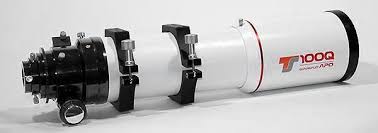Some astronomical images taken from my backyard observatory:
The link to the images. Some okay, some require a better night.
I'm active with astronomy and imaging since 1997. Since 1996, I moved four times for my work. In 2009, I settled in the northern part of the Netherlands. The skies are reasonably dark here, sufficient to do some CCD astronomy with modern cameras.The SQM value in my garden is about 20.4. Imaging is done from my observatory shed in the garden.
The seeing from this sub urban location is reasonable. The only problem is the rare clear nights. At good conditions on images taken near the zenith, the stars are about 3 to 4 arc seconds wide.
Currently I use four telescopes:
| Telescopes in use | Type | Specification | Remarks | |
| TS APO65Q Imaging star also sold under other brands such as Sharpstar |  | Flat Field APO, refractor astrograph | 65mm opening, focal length 420 mm, F/6,5 | Since December 2013. This is a wonderful powerful small refractor astrograph. It has flat and coma free focal area and image scale makes in less sensitive to the seeing and guiding errors. Stars are tiny points. Ideal for wide field. APO, 3 lens element objective and build in flattener lens Dual speed 2" rack and pinion focuser Diameter of the corrected field: 44mm. |
| TS APO100Q Imaging star also know
as SVQ100, Sharpstar 100Q
ED APO astrograph and Tecnosky 100Q. type test report |  | Flat Field APO, refractor astrograph | 100mm opening, focal length 580 mm, F/5,8 | Since September
2014. A "photo machine". The bigger brother of the APO65Q. APO, 3 lens element objective and build in flattener lens Dual speed 3" rack and pinion focuser Diameter of the corrected field: 49mm |
| GSRC6, a 6" Ritchey-Chrétien made by GSO and also sold as AT6RC |  | Ritchey-Chrétien - dual hyperbolic mirror | 152 mm opening, focal length 1370 mm, F/9 | Since april 2014 Workhorse for the longer focal
length images. Rather slow, high focal ratio. Secondary mirror holder obstruction 25% by area BK7 glass, metal tube, Grayford focuser |
| LX200 classic by Meade: |  | Schmidt Cassegrain | 200 mm opening, focal length 1250 mm, F/6,3 | Since mid 2000. I also have a classic 8 inch classic
LX200, native F/6,3. The venerable LX200 F/6,3 is withouta good correction lens no longer suitable for the modern large CCD chips. Closer to the image corners it becomes worse due to the optical imperfections either from coma or quality of the reducer I use. Currently used for visual only. Secondary mirror holder obstruction 18.6% by area |
The mount used in the HEQ5pro parallatic since april 2014.
Field of view some CCD calculations and eyepc projection can be calculated with this Excel spreadsheet
For guiding an old cute
Celestron 90mm f/5.6 Maksutov (500 mm focal length) white
spotting scope is used. The optics are pretty raw and not very
good,
but due to the relative large 90 mm opening, the attached QHY5
mono
guide camera finds always a guide star. It is mounted with
a clamp to the vixen dovetail. It accepts 1.25 inch and the
mirror doesn't shift after some settling time. In November
2014 I bought a CLS light pollution filter. Here
some CLS filter test results
| Cameras in use | Chip |
Active pixels |
Sensor size |
Pixel size | Field of view with APO100Q telescope | Field of view with APO65Q | Field of view with GSO 6" RC | Remarks |
|
| QHY5 mono guiding camera. |  |
CMOS Mitron MT9M001, QE 56 % max. |
1280 x 1024 | 6.7 mm x 5.3 mm | 5.2 x 5.2 µm (2,1 arc sec for 500 mm) (46' x 37') |
- | - | - | In use since 2011 The QHY5 has a large monochrome chip and makes guiding easy |
| QHY8 cooled
OSC (color) camera |
 |
Sony CCD, ICX453AQ |
3040 x 2016 | 28.4 mm diagonal, 23.4 mm width, 15.6 mm height | 7.8 x 7.8µm square | 2.8 arc sec/pixel (93' x 141') | 3.8 arc sec/pixel (126 x 190') | 1.2 arc sec /pixel (40 x 60') | In use since 2011 Color method: RGB BAYER film on CCD, The QHY8 is a cooled one shot color (OSC) camera with a low noise Sony chip. No darks are not required.In December 2013 it was discovered that the QHY8 was suffering from severe tilt. This is now fixed using rubber strips / rubber support. |
| ASI1600MM-Cool, cooled mono imaging camera. |  |
Panasonic CMOS, MN34230ALJ | 4656 x 3520 | 21.9 mm diagonal, 17.6mm width x 13.3mm height | 3.8 x 3.8 µm | 79 x 105' 2.6"/px bin2x2 1.3"/px bin1x1 |
3.8
arc sec bin_x_2 (110' x 145' ) 1.9 arc sec bin_x_1 |
1.2
arc sec bin_x_2 (34' x 44' ) 0.6 arc sec bin_x_1 |
In use since 2016. Cooled mono camera, CMOS. |
| Touptek camera ATR3CMOS26000KMA | Sony IMX571 | 6211 x 4152 | 23.48 x 15.67 mm | 3.76 x 3.76 µm | 92 x 168' 1.33"/px bin1x1 | Cooled mono camera, CMOS In use since 2023 |









